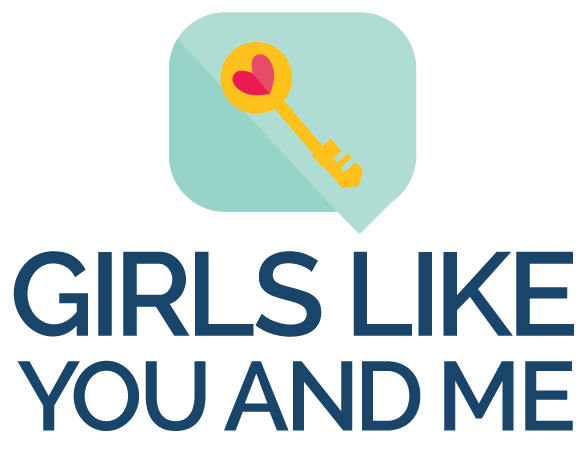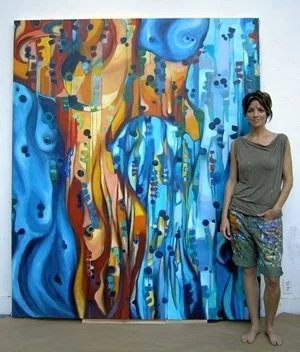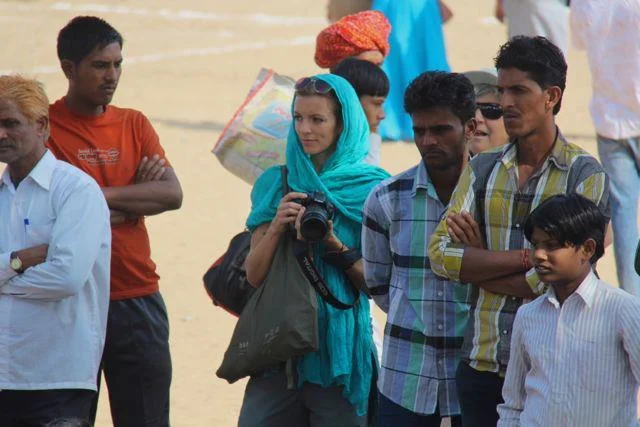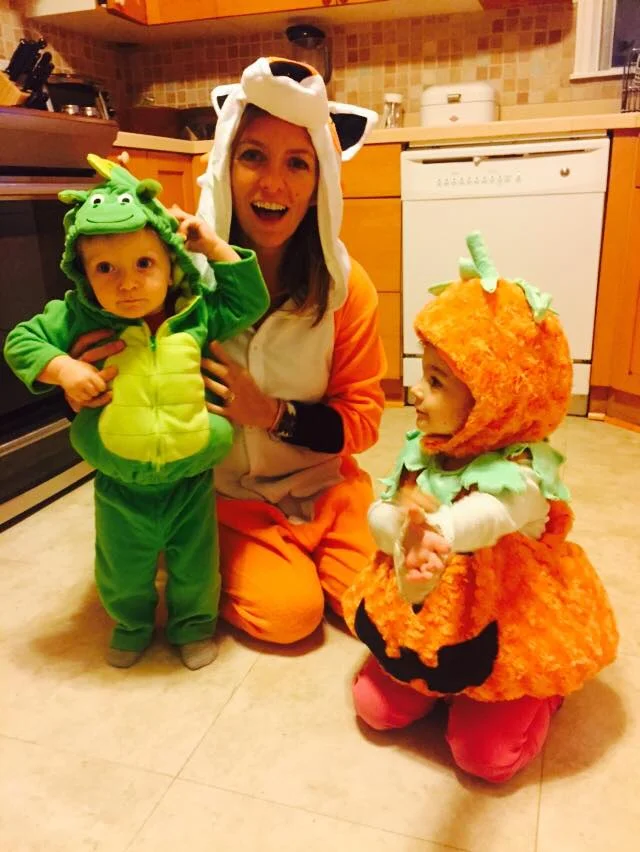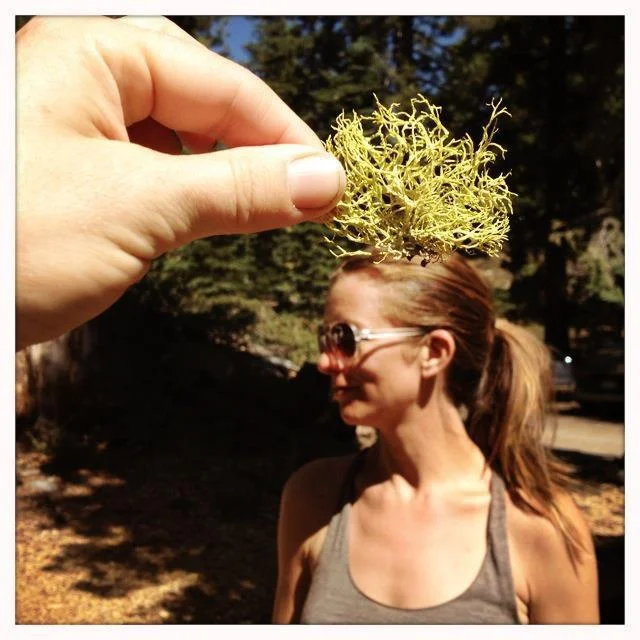Teresa Brazen taps into creativity in Professional education
Teresa Brazen grew up loving art and feeling confident in her ability to create. After working for several years as a visual artist, she decided to look for a new kind of work, but one where she could continue to be creative. That led her to user experience design, and eventually, to teaching people how to use UX design tools for organizational transformation. Today, she leads professional education at Cooper and tells us, "Creativity is something that you can bring into any kind of work, and in a large part it’s really up to you to do that."
Teresa as a girl wth her sister
FAST FACTS ABOUT Teresa
Where she’s from: Atlanta, Georgia
Grew up with: mother, father, sister
Education: Bachelor’s degree in journalism from the University of Georgia
Where she lives now: San Francisco, California
Growing up she wanted to be: an anchorwoman
Now she’s: Senior Director of Professional Education at Cooper
Tell us about yourself growing up!
I lived in Venezuela the first two years of my life. My parents are American and they were were there doing community development work, in a little village in the jungle called Caño Negro. They built a community center and they did some work with water. We lived in basically a little cement box. There were rocks around it to keep snakes out. We had an outhouse for a bathroom. My preschool was made out of bamboo.
We ended up moving back to the states because I kept getting really sick. We came back to the United States. I don’t really remember it, but it shaped my interest in other cultures, my interest in Spanish. We moved to Atlanta, Georgia, and I was there until I was about 30.
In Atlanta, we lived in a lower income black neighborhood. After a year or two my parents put my sister and me into a private school that was mostly white kids. I had this experience of duality where I was living in a lower income black neighborhood, but I was going to school with all these wealthy white kids. It helped me to be nimble, to adapt to different situations. Seeing the difference between a school in the lower income neighborhood and a private school and seeing the difference in what kind of teachers there were and the quality of education was made me a more empathetic person.
I felt like not only was art accessible to me, but it was something I could feel confident about and feel permission to create.
Were you interested in art growing up?
I always was a creative kid. That private school had an amazing art program, and we had two teachers who had the class submit to art competitions all the time. Everybody in the class would create something and submit it. There was one that we won for Handi Wipes. We all created these angels out of Handi Wipes. Another girl and I were picked to go to Washington, DC to accept the award for our class. When I was in that class that I’m talking about, the teachers would model for us. They taught us how to draw the body based just on circles and to figure out proportion based on just using circles and spheres and so I know because I saw as a kid that anybody can learn how to draw a figure with circles. I felt like not only was art accessible to me, but it was something I could feel confident about and feel permission to create.
A lot of adults don’t feel as comfortable with creativity, because perhaps they weren’t in circumstances that made it feel like they have every right to be creative. I was given that foundation as a child, and so I feel comfortable in creative spaces. I feel comfortable with the ambiguity of problem solving and using your creativity to try to figure things out, because I was taught that really young.
Internships give you a chance to see, what is it actually like and is that something that I would want to do?
Why did you choose to major in journalism in college?
I wanted to be an anchorwoman, so I went to the University of Georgia, which has one of the best journalism schools in the US. I learned how to write for radio and production for TV shows, and I did an internship with the local Fox News station. It was a great way for me to see what that life was like. I followed around a reporter and saw how he put together stories and I also created a reel.
It was a good internship, because I realized that I actually didn’t want to do that for a living before I invested career time in it. But I do think that that training has been really helpful to me, in presentation and in public speaking and in teaching. Internships are great. I’ve learned that most jobs that seem glamorous aren’t really as glamorous as they seem. Internships give you a chance to see, what is it actually like and is that something that I would want to do?
Why did you decide to move to the west coast? Were you working as an artist when you made that move?
I was always really attracted to California. I had been a working artist for about seven years. I did big large-scale paintings and video art and exhibited and sold prints of my work, but I was self-taught. I had always been curious about what formal training in art would do for me. I applied to art schools and I ended up getting into California College of the Arts out here in the Bay Area. I was really ready for a change; it made it really easy for me to decide to come out.
I went for about a year and a semester and realized that it wasn’t worth it to me. I didn’t actually need the formal training as much as I thought I did, and I was going to dig myself into a financial situation where I would have to do some other kind of job just to pay my bills and my loans.
I had this existential crisis at the same time where I realized that I didn’t actually want to be a working artist. I realized that I didn’t really want to be by myself painting tons of hours in a studio. I’m actually a very collaborative person and I get a lot of joy and energy out of working with other people. Trying to make work and sell it is a type of business that wasn’t as interesting to me.
I wanted to be creative. What am I going to do? I started with thinking about what kind of environment I wanted to work in,
How did you get into user experience design?
I wanted to be creative but I didn’t want to do it in that way as a job. What am I going to do? I started with thinking about what kind of environment I wanted to work in, because I didn’t know what kind of a job I wanted to have. I thought, I want a creative environment, but that can mean a lot of things. I want to work with lots of different people and different kinds of things, in an environment that’s open to collaboration, and I want to ideally feel good about the kind of work that I’m doing.
I was talking to this woman, describing the environment, and she said, “I know a company that just sounds a lot like what you’re talking about. I can connect you with somebody over there.” She connected me with this woman, Laura, who worked at a design firm called Adaptive Path in the UX field and I got along with her really well when I called and she said, “oh, we have a project management position open.” I had done project management in other work. I went in for an interview and really liked them and really liked the environment. I was attracted to the fact that it was a creative agency and that user experience design is all about creating great experiences for people. It was a really nice mesh of two things I cared about, creativity and doing good by people.
It was a really great organization. It was relatively flat and very, very open and collaborative. For example, they’d have what they called open design sessions where a team would open something they were trying to tackle in a project up to the whole company. Everybody would come and brainstorm on it, not just designers, but sales staff, administration. I loved that kind of environment. That’s how I fell into it. I was thinking about the kind of place that I wanted to work without knowing what kind of job and found an organization that was a good fit.
Teresa credits her early childhood in Venezuela for her love of travel.
You were at Adaptive Path for about four years and then you moved to Cooper. How did you get into the education side of things?
I moved into program management at Adaptive Path. Someone that I worked with there, Kendra Shimmell, ended up coming over to Cooper to grow their training line of business. About a year after she came here, she asked me if I wanted to come work with her. She said, “I know from having worked with you a bunch of different kinds of things that you like to do. We could create something that you would really enjoy and capitalizes on all of that.”
I came in first doing some marketing because I had some marketing background, and working with her on curriculum. Not too long after that, I said, “Wow this is really hard for me to have my head split between marketing and classes.” I stopped doing marketing and just focused on the training part of the business. I learned how to be a teacher here, and I learned in a large part because I got thrown into it and had to figure it out. I taught with people that were really good and I watched how they did it and I took a lot of notes.
There are a lot of tools that I use in classes: my art past and improv skills; skills that I learned in my journalism training; storytelling, being comfortable in a room in front of a bunch of people telling stories, asking provocative questions that get people thinking. I’m also really attuned to what people need in order to really access their creativity and to think really innovatively.
How do we design the optimal experience for people to learn and to access their creativity and feel comfortable taking risks in front of people they don’t necessarily know? I learned by doing and by watching and by tapping into things that I had done in the past.
What is your role as the Senior Director of Professional Education within Cooper?
I run the training program, so I’m responsible for the vision and direction of everything we do that is training-related. I have a team that I work with. I have a partner, Holly Thorsen, who’s focusing on curriculum design and teacher training. I’m responsible for making sure that we have the teachers that we need and that they’re good teachers and that they know how to teach in the Cooper style and create really great experiences for people. I’m responsible for what it is that we’re teaching and how we’re teaching it.
I’m thinking about what is it that organizations need in terms of the skills and the mindsets of the people inside their organizations that will help them as an organization be more innovative and come up with really compelling products and services. What do they need to be able to do that? Then we work backwards from there. What could we offer to support that that we could teach people when they come to our classes or when we do coaching with teams privately?
Now I’m thinking about how we evolve our services so that we create even better learning experiences for people and thinking a lot about how we help organizations transform. We do a lot of private training for companies and that training is usually in service of some kind of transformation that’s going on inside the company.
The fact that most of our practitioners teach comes out in the way that we consult.
How do training and education tie into the consulting work that Cooper does?
Consulting and training are intertwined. Sometimes we do consulting projects and we also include training, because the team wants to learn some of the skills that we’re using to create a product or to help them think about their product or service strategy.
Sometimes they come to us because they want training. Sometimes we do consulting projects and then they want training later. Sometimes we do training and then they say, “Oh, we have this other project and we don’t have the capability to do that. Do you guys want to do it?” And so we do a consulting project.
In addition to that, there’s an element of training in the way that we consult. A lot of times people are learning about the tools and methods that we use as we work on a consulting project with them, even just by how we conduct workshops and how we’re using certain tools like journey maps or personas. The fact that most of our practitioners teach comes out in the way that we consult.
What keeps you excited about user experience design and teaching people about how to do it?
I’ve discovered that I’m very entrepreneurial and I love the process of building this business. It’s super fun to think about, “What are the new ways that we could really empower people inside of organizations and help them have more impact or help hold teams?” There’s a gazillion different ways that you can do that.
Teresa with her kids
I’m also a big advocate of education, so I feel really good about working in this space. I love and believe in the UX design approach as a problem solving approach, but nowadays, I’m even more interested in organizational change. I think what we’re doing is actually in service of an organizational culture-shifting mindset and teaching people tools and methods in service of larger, systemic changes.
In all of our classes, there’s an effort to help people develop leadership skills. How do we teach you how to design a good product? How do you actually influence the people inside your organization while you do that so that it can actually be designed, built and go to market? The last few years I’ve become a lot more interested in organizational culture and the larger transformation of those big communities and how training can support that. It’s not just about skills; it’s about mindset shift, too.
We’re teaching how to actually facilitate that process. We’re going to teach you an ideation tool and you’re going to get some practice with it. We’re also going to teach you how to facilitate a whole room of diverse stakeholders using that tool so that your team comes up with better ideas, and you are the person who’s seen as responsible for shepherding that process.
What fills your time outside of work?
Well, I have two little kids and I love to play with them. That’s what I spend a lot of time doing. I have a one-year-old and a three-year-old. My husband and I get a lot of practice using our improv skills and our storytelling skills and we play a lot more now that they’re in our lives than we did before, so it’s awesome.
Creativity is something that you can bring into any kind of work, and in a large part it’s really up to you to do that.
Bringing a little creativity into the everyday.
What advice would you give someone who wants to either be in user experience or find a way to be creative in their career in some way?
Creativity is something that you can bring into any kind of work, and in a large part it’s really up to you to do that. Creativity in a way is just a mindset that you have to bring to your own work. There’s a gazillion different ways to solve problems or to do things day-to-day. You can be creative about how you structure meetings. As a simple example, on Monday mornings we all do an improv exercise together. That’s just part of the ritual of things that we do around here.
I know another organization that every Friday they have a 15-minute creative exercise and everybody in the company does it. I think it’s really important because it makes your work more enjoyable, but it also helps you exercise muscles that are really useful in most if not all jobs. It helps you to solve problems in interesting and different ways. If you have some kind of regular practice of bringing creativity into your work, I think it helps you to do that.
Did you have an idea what you wanted to do as a kid? What do think your childhood self would think of what you’re doing now?
There is not one iota of my life that looks anything like what I imagined when I was a child. Nothing. Not where I live, the children that I have, the job that I have, none of it. I wasn’t someone who saw this really clear path for what I wanted to do in life. I’ve just always been a curious person and seized opportunities when they were in front of me and explored them until I figured out whether they were the right thing for me or not. So far, that’s worked for me.
On a big picture level, I am someone whose story is about meandering into the right thing. I have a very eclectic path and what’s been interesting to me as I’ve gotten older is seeing how I can use all those different things and how that’s helped round me out and given me a lot of tools to use in my work today.
This interview has been edited and condensed.
Check out book Teresa loves!
